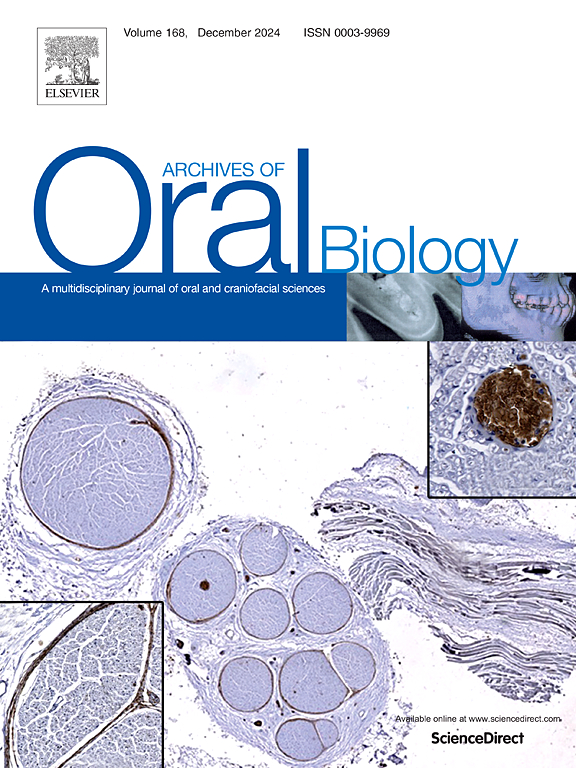B. lactis HN019 modulates periapical inflammation and enhances cementum repair by increasing CEMP-1 expression in an animal model
IF 2.1
4区 医学
Q2 DENTISTRY, ORAL SURGERY & MEDICINE
引用次数: 0
Abstract
Objective
To investigate the effect of the HN019 probiotic on the modulation of inflammation and the resorption of mineralized tissues in experimentally induced periapical lesions in an animal model, evaluating its impact on the expression of cementum protein 1 (CEMP-1).
Design
Periapical lesion was induced in 45 Wistar rats. The animals were divided into groups according to the irrigating solution used. Root canals were irrigated on days 7 and 14. After 21 days, the animals were euthanized, and mandibles were processed for histological analysis. Descriptive and semi-quantitative evaluations of the inflammatory infiltrate, periodontal ligament, bone and cementum resorption, as well as counts of inflammatory cells were performed using HE staining. Also, to assess cementum formation, tissue sections were stained with an antibody for CEMP-1 and analyzed by immunohistochemistry.
Results
In the Infection + Probiotic Group, the inflammatory infiltrate was mixed and diffuse, ranging from mild to severe, with no statistically significant difference compared to the Control Group (p > 0.05). However, in the Infection + Probiotic Group, cementum resorption was significantly lower compared to Control Group (p < 0.001). Moreover, CEMP-1 expression was significantly higher in Infection + Probiotic-Group compared with all other groups (p < 0.0001).
Conclusion
The probiotic HN019 significantly increased CEMP-1 expression, indicating cementum formation in periapical lesions in vivo. These findings suggest that B. lactis HN019 may have regenerative potential in clinical scenarios. Furthermore, this strain appears to modulate the inflammatory state of periapical lesions toward a reparative phenotype, characterized by reduced bone resorption. Also, inflammatory infiltrate was like control group.
在动物模型中,B. lactis HN019通过增加cmp -1的表达来调节根尖周围炎症并促进骨质修复。
目的:通过动物模型研究HN019益生菌对实验性根尖周病变中炎症和矿化组织吸收的调节作用,评估其对骨水泥蛋白1 (cementum protein 1, cmp -1)表达的影响。设计:45只Wistar大鼠根尖周围病变。根据所使用的灌洗液进行分组。在第7天和第14天进行根管冲洗。21天后,对动物实施安乐死,并对下颌骨进行组织学分析。采用HE染色对炎症浸润、牙周韧带、骨骨质吸收、炎症细胞计数进行描述性和半定量评价。此外,为了评估骨质形成,组织切片用cmp -1抗体染色,并通过免疫组织化学分析。结果:感染+ 益生菌组炎症浸润呈混合性、弥漫性,轻重有别,与对照组比较差异无统计学意义(p > 0.05)。而感染+ 益生菌组骨质吸收明显低于对照组(p )结论:益生菌HN019显著提高了cmp -1的表达,提示体内根尖周病变中骨质形成。这些发现提示乳杆菌HN019在临床可能具有再生潜能。此外,这种菌株似乎可以调节根尖周围病变的炎症状态,使其向修复表型发展,其特征是骨吸收减少。炎症浸润与对照组相似。
本文章由计算机程序翻译,如有差异,请以英文原文为准。
求助全文
约1分钟内获得全文
求助全文
来源期刊

Archives of oral biology
医学-牙科与口腔外科
CiteScore
5.10
自引率
3.30%
发文量
177
审稿时长
26 days
期刊介绍:
Archives of Oral Biology is an international journal which aims to publish papers of the highest scientific quality in the oral and craniofacial sciences. The journal is particularly interested in research which advances knowledge in the mechanisms of craniofacial development and disease, including:
Cell and molecular biology
Molecular genetics
Immunology
Pathogenesis
Cellular microbiology
Embryology
Syndromology
Forensic dentistry
 求助内容:
求助内容: 应助结果提醒方式:
应助结果提醒方式:


